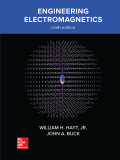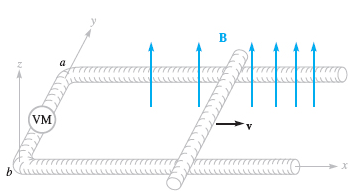
Engineering Electromagnetics
9th Edition
ISBN: 9781260029963
Author: Hayt
Publisher: MCG
expand_more
expand_more
format_list_bulleted
Concept explainers
Textbook Question
Chapter 9, Problem 9.5P
The location of the sliding bar in Figure 9.5 is given by x = 5t + 2t3, and the separation of the two rails is 20 cm. Let B = 0.8x2az T. Find the voltmeter reading at (a) t = 0.4 s; (b) x = 0.6 m.

Expert Solution & Answer
Want to see the full answer?
Check out a sample textbook solution
Students have asked these similar questions
B) A 60-Hz generator is supply ing 60% of P max to an infinite bus through a reactive network.
A fault occurs which increases the reactance of the network between the generator internal
voltage and the infinite bus by 400%. When the fault is cleared, the maximum power that can
be delivered is 80% of the original maximum value. Determine the critical clearing angle for
the condition described.
Q3)
A: A generator operating at 50 Hz delivers 1 pu power to an infinite bus through a transmission
circuit in which resistance is ignored. A fault takes place reducing the maximum powe transferable
to 0.5 pu whereas before the fault, this power was 2.0 pu and after the clearance of the fault, it is
1.5 pu. By the use of equal area criterion, determine the critical clearing angle.
4. For the periodic signal shown in Fig. 4;
a) Find the exponential Fourier Series for y(t).
b) Use Parseval's Theorem to compute the total power contained in the 4th harmonic and all higher
harmonics.
2+
y(t)
+
-2л
-л
0
2л
Зл
4л
Fig. 4
Chapter 9 Solutions
Engineering Electromagnetics
Ch. 9 - Prob. 9.1PCh. 9 - Prob. 9.2PCh. 9 - Prob. 9.3PCh. 9 - A rectangular loop of wire containing a...Ch. 9 - The location of the sliding bar in Figure 9.5 is...Ch. 9 - Prob. 9.6PCh. 9 - The rails in Figure 9.6 each have a resistance of...Ch. 9 - A perfectly conducting filament is formed into a...Ch. 9 - A square filamentary loop of wire is 25 cm on a...Ch. 9 - (a) Show that the ratio of the amplitudes of the...
Ch. 9 - Let the internal dimensions of a coaxial capacitor...Ch. 9 - Prob. 9.12PCh. 9 - En free space it is known that E = E0/r sin...Ch. 9 - A voltage source V0, sin cot is connected between...Ch. 9 - Use each of Maxwells equations in point form to...Ch. 9 - Derive the continuity equation from Maxwells...Ch. 9 - The electric field intensity in the region...Ch. 9 - Prob. 9.18PCh. 9 - In Section 9.1. Faradays law was used to show that...Ch. 9 - Prob. 9.20PCh. 9 - (a) Show that under static field conditions; Eq....Ch. 9 - Prob. 9.22PCh. 9 - Prob. 9.23PCh. 9 - A vector potential is given as A = A0 cos(đ�œ”t =...Ch. 9 - Prob. 9.25PCh. 9 - Write Maxwells equations in point form in terms of...
Knowledge Booster
Learn more about
Need a deep-dive on the concept behind this application? Look no further. Learn more about this topic, electrical-engineering and related others by exploring similar questions and additional content below.Similar questions
- 2. a) Find the Fourier transform of the signal shown in Fig. 2 and express it in its most compact form; b) Find the value of the energy spectral density at f=1/4. 0 -2 -1 -3. Fig. 1 g(t) 3 1 2 t- Fig 2arrow_forward5. Consider a filter whose transfer function is: H(f) = -12xfß (a + jπ f ) ² (a) show that the filter is non-causal for α = 3, p= -1; (b) choose alternate values of α, ẞ that result in a causal filter, and demonstrate that your choice valid.arrow_forward1. Referring to the signals shown in Fig. 1: a) Find the signal energy of x(t). 6 b) Find the signal energy of y(t) . c) Find the signal energy of x(t)+y(t) . d) Are x(t) and y(t) orthogonal? Explain how you can tell. x(t) 0 2 4 y(1) 2 0 2 4 -6 Fig. 1 1-arrow_forward
- Please can you solve this question correctly in a step by step form to help understanding, please make it clear.arrow_forwardPlease can you solve this question in a step by step form correctly, please look at the refernces provided on the data path control lines, the GPLB functions, the processor instruction setarrow_forwardPlease can you solve this question in a step by step form correctly, please look at the refernces provided on the data path control lines, the GPLB functions, the processor instruction setarrow_forward
- Please can you solve this question in a step by step form correctly, please look at the refernces provided on the data path control lines, the GPLB functions, the processor instruction set and using the PLA personality chart.arrow_forwardPlease can you solve this question correctly in a step by step form to help understanding, please make it clear.arrow_forwardI just want to know what is PPE and Give examples of itarrow_forward
- Why is a starting resistor needed to bring a motor up to speed? Show one way to reverse the direction of ro- tation of a compound motor.arrow_forward8- is flip-flop which indicates some condition which arises after the execution of an arithmetic or logic instruction. a) Status flag b) Instruction registers c) Temporary register d) None of these 9- El instruction is a_ a) Branching Instructions b) Logical Instructions c) Control Instructions d) Data Transfer Instruction e) Arithmetic Instructionsarrow_forward1. Write a program to add 4 hex numbers located in the memory locations 2001h, 2002h, 2003h, 2004h and store the result at location 2005harrow_forward
arrow_back_ios
SEE MORE QUESTIONS
arrow_forward_ios
Recommended textbooks for you
 Delmar's Standard Textbook Of ElectricityElectrical EngineeringISBN:9781337900348Author:Stephen L. HermanPublisher:Cengage Learning
Delmar's Standard Textbook Of ElectricityElectrical EngineeringISBN:9781337900348Author:Stephen L. HermanPublisher:Cengage Learning Power System Analysis and Design (MindTap Course ...Electrical EngineeringISBN:9781305632134Author:J. Duncan Glover, Thomas Overbye, Mulukutla S. SarmaPublisher:Cengage Learning
Power System Analysis and Design (MindTap Course ...Electrical EngineeringISBN:9781305632134Author:J. Duncan Glover, Thomas Overbye, Mulukutla S. SarmaPublisher:Cengage Learning

Delmar's Standard Textbook Of Electricity
Electrical Engineering
ISBN:9781337900348
Author:Stephen L. Herman
Publisher:Cengage Learning

Power System Analysis and Design (MindTap Course ...
Electrical Engineering
ISBN:9781305632134
Author:J. Duncan Glover, Thomas Overbye, Mulukutla S. Sarma
Publisher:Cengage Learning
Demos: Dielectric breakdown; Author: Caltech's Feynman Lecture Hall;https://www.youtube.com/watch?v=2YrHh1ikefI;License: Standard Youtube License